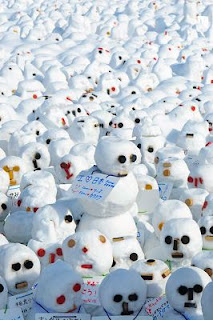 Alright this will be my last ever post on Live View - I promise! But I just had to let you know about this trick, with one caveat. I know my camera does this but I don't know if every one does. So, as they say in geek speak - YMMV - or for those of us who prefer good old English - Your Mileage May Vary.
Alright this will be my last ever post on Live View - I promise! But I just had to let you know about this trick, with one caveat. I know my camera does this but I don't know if every one does. So, as they say in geek speak - YMMV - or for those of us who prefer good old English - Your Mileage May Vary.Exposure compensation is one of those confusing little functions on cameras. A lot of people aren't really sure how to use it, or when to use it, or even if they need to use it.
Well the answer to the above questions are: yes you most likely need to use it. You need to use it when the subject of your photograph is really white (like snow, sand) or really black (like cameras). And how to use it? Well that's the tricky bit.
Why you need it in a nutshell. When camera boffins invented the light meters in cameras they had to work out how to get a good exposure so you could take a photo in almost any condition and get a good result. So they took an average mix of lighting situations and stuck 'em all together in a metaphorical bucket and came to the conclusion that the meter needed to read 18% grey. In other words a scene of 'average reflectance' would be 18% grey. And for a lot of situations they were right.
Only not everything works that way. Our little snowmen above for instance would look pretty ordinary as 18% grey, so we have to use the exposure compensation button to lighten our exposure and turn them back to white again. Exactly how much compensation we need is a bit of a dark art, shrouded in mystery. There's no hard and fast rule and it was always a bit hit and miss with film. Often you made a judgement based on experience and guesswork rather than any science.
With digital came the histogram. If you looked at the back of your camera after taking an image and noticed that the histogram was too far to the left then you moved your exposure compensation and took another photograph, checked the image and continued to do that until you got the right exposure. Pretty fool proof but can be a bit time-consuming.
Now with Live View you can check the effects of exposure compensation on the fly. You might have to enable it in the Custom Functions of your camera but once you do that things are set up so that when you point your camera at an object, switch Live View on and then fiddle with the exposure compensation button you can actually see the picture get brighter and darker with each increase or decrease in exposure.
Seeing things visually always helps you understand difficult concepts so much more easily I find and doing it this way is very intuitive. Using the histogram meant you might have to take two or three shots in a row until you get the exposure you want, whereas if you view it on the LCD you can actively judge the image while you look at it getting brighter or darker and choose when to stop. This is a great time saving feature and I think a really good way of getting a feel for exposure compensation and how it works.
And that's all I have to say about Live View forever and a day!

No comments:
Post a Comment